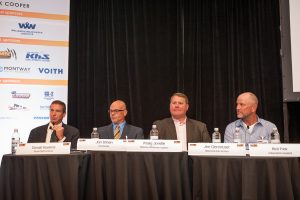 OEMs and logistics providers are naturally concerned about getting vehicles into the hands of customers without a single scratch. That is part of what has driven an increase in focus, data and communication across the supply chain, including the establishment and tracking of more KPIs and analysis into the cause of each incident, according to executives at the sixth Finished Vehicle Logistics North America conference.
OEMs and logistics providers are naturally concerned about getting vehicles into the hands of customers without a single scratch. That is part of what has driven an increase in focus, data and communication across the supply chain, including the establishment and tracking of more KPIs and analysis into the cause of each incident, according to executives at the sixth Finished Vehicle Logistics North America conference.
However, those from carmakers and logistics providers said that damage incidents still occur regularly at great cost and delay to vehicle logistics, with complex and sometimes inefficient claims management.
Damage comes in many forms, of course, from natural events such as hailstorms or extreme weather, to car accidents, mishandling or other issues in transport. In some cases, the issues can be technical as well. According to Jonathan Urban, damage prevention specialist at Fiat Chrysler, vehicle clearance, securing methods and protection are changing, as there are no longer fixed loops, or tie down hooks in use, with different points used for vehicle lashing.
To deal with these changes, it is important for the carmaker to discuss the issue across its many internal departments, so that logistics managers can educate everyone from designers to engineers about how they might resolve potential issues with quality. This allows Fiat Chrysler to assess a vehicle, see any potential problems, and figure out how to transport vehicles after they eliminate the ways they are secured.
Fiat Chrysler is also in constant communication with supply chain partners through field audits and monthly forums with carriers and regional business centres. Urban explained that simplifying its processes has reduced claim approval and repair significantly.
The OEM also collaborates with industry workgroups and advocates for the implementation of best practices that benefit the entire industry, including partners and customers. Donald Hawkins, senior manager of vehicle logistics for Nissan North America agreed that a global approach to quality is important. “We have global meetings with Nissan where we all gather together and discuss KPIs for quality,” he said. The results of these can then be communicated back to the manufacturing team.
If there is an anomaly in the chain, where a dealer is reporting significantly higher claim rates, Fiat Chrysler will go direct to the dealer to find out whether the issue is with the carrier, provider, driver or a relationship issue. The problem could also be with the dealers themselves. For example, the biggest common thread the carmaker sees is dealers claiming things they shouldn’t, said Urban. If there is a dealer submitting damage rates of 5-6%, but everything else leading up to it is less than 1%, it needs investigating. Some dealers are submitting small, frivolous claims over items that should have been on warranty, for example. Urban said that Fiat Chrysler will sit down and confront dealers with the data.
Getting carmakers to act
Kraig Jondle, vice-president at WWL, agreed that collaboration is key but that it currently doesn’t necessarily work that efficiently. Communication between manufacturing and logistics is not always good, for example. “Years ago there was a port rep from the OEMs, but that’s gone now,” he said.
Within WWL, Jondle said that the right people are the most important asset to quality management, and a global approach needs to be taken. “You need to clarify quality programme principles and goals, and establish KPIs, defined measurement criteria, and align with the OEM on metrics,” he said.
If a workforce is not focused on quality, companies have to spend time repairing vehicles, and can lead to further supply chain disruptions, Jondle added. However, while WWL will look to make improvements, it is down to the OEMs to approve changes. “On the processing side of the business, we do what we’re told to do and get paid for what we do,” he said. “We’ve gone back to OEMs to talk about lashing points, and the next thing, they get removed. We’re all about collaboration but we can only do what we do with the cars.”
Customers already have to wait significantly longer for a new vehicle than they do for many other products. Any further delay to delivery caused by damage will become less and less acceptable. Better communication on a global scale between all aspects of the supply chain, including manufacturing, engineering, logistics and logistics providers, are vital to improving the damage rates that can dent an OEM’s reputation.
Video recordings of the main sessions at this year's Finished Vehicle Logistics North America conference can be viewed by clicking here.

























![Global[1]](https://d3n5uof8vony13.cloudfront.net/Pictures/web/a/d/s/global1_726550.svgz)









